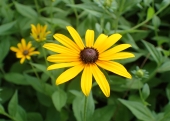I don't have much experience, but this seems to be working. I live in the city of Lowell Massachusetts (zone 6) and have a small amount of land (less than 270 meters^2).
I started with poor land (half bare, lots of dyeing plants, powder soil that repels water, probably lots of lead).
I have some slope problems that I have put off for next spring. Dealing with slopes is important. In nature, you don't find soil at the top of a steep mountain. I also heard that "Shit rolls downhill."
First I tried to establish more cover. I planted cover crop mixes with as much variety as conveniently possible. I planted often throughout the year. I planted the most of a species when I thought conditions were best for it. The charts at sare.org helped a lot for designing mixes and when to plant them. I inoculated my legumes.
Reasons for cover cropping:
- stop erosion
- increase water permeability
- Plants feed the soil.
- to mine nutrients
- shade: My strawberries grew better where they were surrounded by grass.
My favorite purchased cover crops, and about how much I used:
4 lbs Buckwheat: quick establishment, best pioneer, best drought tolerance when young
10 lbs winter rye: great at growing in the cold
15 lbs hairy vetch: cheaper than dirt, was $0.5/lb, great when wet and semi-cold, good drought resistance, favorite
3 lbs clovers: tough, long lasting
I used chemical fertilizer, lime, and pH tests. These are unnecessary and can hurt soil, but I think they can be a good temporary way to get faster results.
I planted a small amount of diverse crops, and did chop and drop.
Chop and drop goals:
- get enough light to crops
- Keep hairy vetch from smothering.
- rot dead stuff faster
Compost
I applied this from a pile that I started last year. I tried to add diverse organisms to the compost when I started it. I added a tiny bit of various mushrooms and dirt samples. I had about 8 meters^3 (Next year's pile will be bigger.) It was never turned, and it wasn't fully composted. I think that fully composting is a waste of time. I also think that most compost bins (including the one I made with free pallets) are unnecessary. Most of the compostable material came from "yard waste" (mostly leaves). I stuffed my truck with it when coming home from my parents. I probably got 10 truck loads this year.
I have a great compost location. It's the one spot with huge trees nearby to feed it.
I applied the compost in a polkadot pattern of mounds so there would be plenty of plants to feed it.
In the future I won't need to make a compost pile. I should be able to get all the nutrients I need by directly applying yard waste (from my neighbors) in a polkadot pattern.
I planted a lot of tubers (sunchoke, potato, groundnut). It's easy to grow a tuber in uncomposted yard waste. I plan to grow many tubers without digging by dropping yard waste on them.
My fertilizer advice for those with large flat land :
Get people to dump fertilizer on your land, and have them pay you to do it.
possibly more to come + pictures






